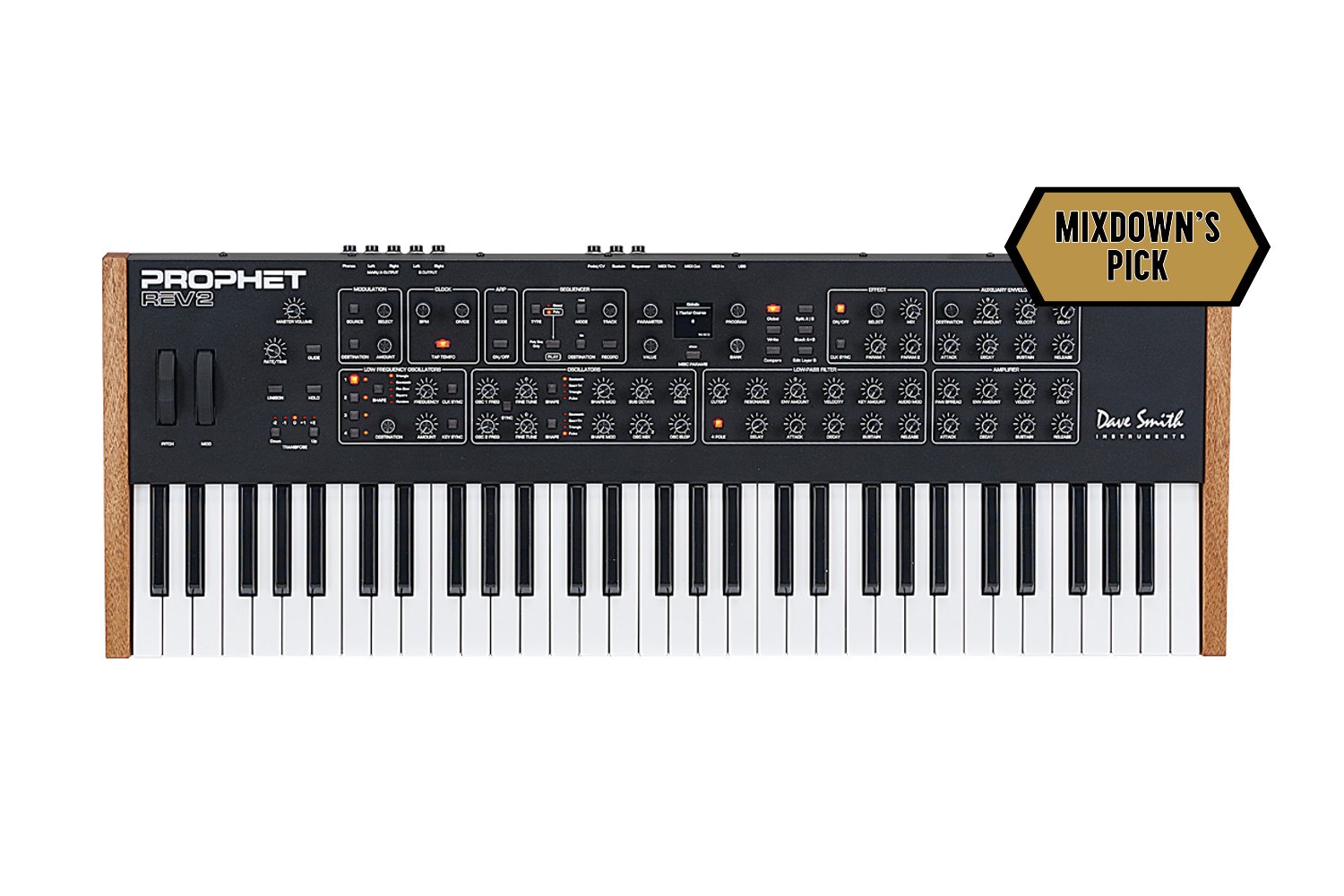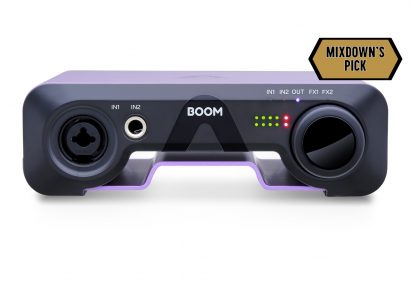Focusrite Australia | RRP: $3,199 (8 Voice), $4,199 (16 Voice)
Upon its release back in 2007, the Prophet 08 was an overnight success. It was a welcome update to users looking for that classic Prophet sound in a more reliable, accessible format that made it perfect for creating sounds in the studio or performing live. Its fizzing filter and sleek black design became ubiquitous. The Sequential Prophet Rev2 is the aptly named second revision that builds on the strengths of the Prophet 08 by adding expanded features and capabilities.
In keeping with the 08 design (and most Dave Smith-designed Prophets), the Rev2 features a suave black finish and classy African mahogany wood end panels. Being a knob-per-function synthesiser makes the knob build quality important and they feel reassuringly secure with a pleasant resistance in use. The five-octave velocity and aftertouch-sensitive keyboard is semi-weighted and performs with the quality touch that you’d expect from Sequential.
Read more gear reviews here.
The two DCO analogue oscillators are essentially the same as those in the previous revision. The foremost improvement is the ability to vary the pulse-width of any of the four wave shapes by dialling them in with the dedicated knob or modulating them with one of the four LFOs. This allows for everything from subtle vintage-style wave shape instability to dramatic morphing experimental sounds. The oscillator slop function introduces pitch errors at variable rates to the voices, which can add a bit of characteristic instability, though it’s worth clarifying that if you want the bold VCO sound of the vintage Prophets, there are better models in the Sequential range for that.
The Rev2 is available in two models; either eight or sixteen-voice polyphony. Both allow for bi-timbral playing via a split mode, or halving the voices but playing two different patches simultaneously in layer mode. This opens up the sonic complexity significantly and a second stereo output allows you to record both patches at once, perfect for recording while the creativity is flowing or having more control over your signal path if performing live and wanting to incorporate FX pedals to separate patches.
As is becoming increasingly common, assigning mod matrix parameters is as simple as holding the button and turning the source knob. Compared to the Prophet 08, modulation capabilities have doubled with eight separate mod paths and a host of new sources (22 in total) and destinations (53 in total). Sound designers will be in their element, from atmospheric stereo pans to dynamic aural textures.
The buzzy, whistling filter is the same classic Curtis chip design as the 08 Prophet. It can be switched between a two-pole 12dB curve and a four-pole 24dB curve, the latter having noticeably more resonance and will self oscillate when set to its maximum setting. With both key-tracking and an audio modulation knob (which feeds oscillator one into the filter cutoff), the sine wave from the self-oscillating filter opens up the possibility for two operator frequency modulation synthesis. The central critique here would be the notable absence of an analogue high pass or band pass filter, but the digital FX engine has a resonant high pass filter.
The FX engine features all the classics you need for polyphonic synthesiser design: chorus, reverb, multiple delays, multiple flangers, multiple phasers, ring modulation, distortion, and the aforementioned high pass filter. Each with its own parameters that can be set as modulation destinations in the mod matrix. You can select one effect per patch, which means using the split or layer functions you can use two.
The five-stage envelope design with delay, attack, decay, sustain, and release also carries on from the Prophet 08. With both dedicated VCA and VCF envelopes and a third loopable envelope to broaden the sonic design possibilities. They range perfectly from the short and snappy for blips and stabs up to the slow and cinematic for washy pads. All three envelopes have a velocity knob to dial in the precise amount of keyboard velocity variance and a pan spread knob makes affecting the stereo position of the voices a breeze.
The Rev2 features two types of onboard sequencers; polyphonic and gated. Polyphonic mode records notes as you play them and plays them back quantised to the beat selected by the BPM and beat division settings. There are rests and ties to make things more dynamic and this serves well as an idea ‘scratch pad’ of sorts. The split function works well here as you can have one patch playing such as some chords or a bassline and play along over the top with another patch. It’s 64 steps long which is as much as I would need in a sequencer of this style and would prove handy in live situations when you want to keep things moving between other sequencers.
The second gated sequencer is 16-step and four-track and can be used either for notes or modulation tracks. These four tracks don’t have to be the same length meaning you can create some complex polyrhythmic sequences. With so many mod sources and LFOs, the automation can make things very interesting and can lead to some wondrous generative tones.
The Rev2 has been out for five years now and it’s fair to say its reputation is still growing. Sequential took a good workhorse synth and expanded it into a modern-day classic. I’ll admit that even though I knew it was a capable and respected instrument that the Prophet 08 never quite clicked with me. The Rev2 however is immediately inspiring and with such a deep analog engine I can’t imagine getting bored of it any time soon.
It’s fair to say that unless you hate the sound of Curtis filters or turn your nose up at any DCO polysynth that you’re going to enjoy playing the Sequential Rev2, which is why they’re becoming increasingly common to see both in studios and on stage.
Head to Sequential for more information. For local enquiries, reach out to Focusrite Australia.

